
Root Canal
What is root canal treatment?
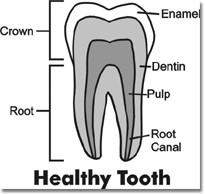 The pulp, or soft inner tissue of your tooth, is normally surrounded and protected by a layer of dentin. Above the gumline, the dentin is protected by a layer of enamel; below the gumline, the dentin is covered by cementum. When a deep cavity, decay or crack destroys these protective layers, the pulp is exposed to the bacteria in your mouth. This can result in inflammation, infection and, eventually, necrosis (pulp death). A severe blow to the tooth can also damage the pulp. Irritants may then escape from the end of the root and cause a diseased area (apical lesion) in the bone.
The pulp, or soft inner tissue of your tooth, is normally surrounded and protected by a layer of dentin. Above the gumline, the dentin is protected by a layer of enamel; below the gumline, the dentin is covered by cementum. When a deep cavity, decay or crack destroys these protective layers, the pulp is exposed to the bacteria in your mouth. This can result in inflammation, infection and, eventually, necrosis (pulp death). A severe blow to the tooth can also damage the pulp. Irritants may then escape from the end of the root and cause a diseased area (apical lesion) in the bone.
Root canal treatment removes the damaged pulp and irritants. This allows the bone surrounding the root end to repair and heal.
Couldn’t I just have the tooth removed?
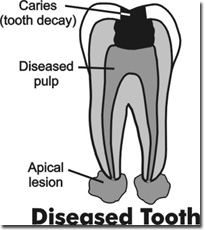 You could, but then adjoining teeth may shift and interfere with biting and chewing. You can have a replacement tooth implanted or attached to adjacent healthy teeth, but this can be expensive and require even more dental treatment. There is no real substitute for your own tooth, which is more efficient in chewing and biting than an artificial one would be.
You could, but then adjoining teeth may shift and interfere with biting and chewing. You can have a replacement tooth implanted or attached to adjacent healthy teeth, but this can be expensive and require even more dental treatment. There is no real substitute for your own tooth, which is more efficient in chewing and biting than an artificial one would be.
How much does root canal treatment cost?
The cost of root canal treatment depends on the severity of your problem, as well as the tooth location and number and shape of canals.
What happens during root canal treatment?
An examination, including radiographs, will be performed. A local anesthetic will be given, if necessary. A sheet of latex, called a “rubber dam,” will be placed around the tooth to isolate it and keep it clean and dry during treatment. Complete treatment consists of the following five basic steps:-
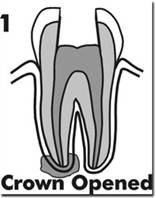 Step 1. An opening is made in the crown of the tooth.
Step 1. An opening is made in the crown of the tooth.
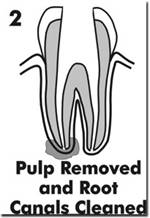 Step 2. The pulp is removed from the pulp chamber and root canals. Tiny instruments (“files”) are used to clean the root canals and shape them to a form that will ensure they will be well sealed. A temporary filling is placed in the opening to seal the opening and protect the tooth between visits.
Step 2. The pulp is removed from the pulp chamber and root canals. Tiny instruments (“files”) are used to clean the root canals and shape them to a form that will ensure they will be well sealed. A temporary filling is placed in the opening to seal the opening and protect the tooth between visits.
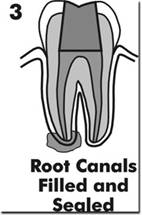 Step 3. The root canals are filled and sealed with a material that prevents bacteria from re-entering. The opening in the crown of the tooth is sealed with a temporary filling. Radiographs (x-rays) are made before, during and after treatment.
Step 3. The root canals are filled and sealed with a material that prevents bacteria from re-entering. The opening in the crown of the tooth is sealed with a temporary filling. Radiographs (x-rays) are made before, during and after treatment.
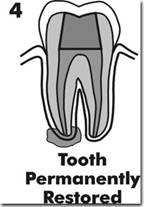 Step 4. At future appointments, which may be in another department, the temporary filling will be replaced with a permanent filling and/or crown.
Step 4. At future appointments, which may be in another department, the temporary filling will be replaced with a permanent filling and/or crown.
 Step 5. The root canal, permanent filling, and/or crown are evaluated for healing at periodic intervals called recall appointments.
Step 5. The root canal, permanent filling, and/or crown are evaluated for healing at periodic intervals called recall appointments.
Is this going to hurt?
With modern techniques and anesthetics people report that having a root canal treatment is about as unremarkable as having a cavity filled. Should you experience any discomfort, signal your dentist, who will do everything possible to make you comfortable.
How long will my tooth last?
Although the pulp is removed, your tooth remains alive, nourished by surrounding bond and gum tissues. With a permanent restoration, regular brushing and flossing, proper diet and periodic dental checkups, your tooth has an excellent chance for success.
After a Root Canal
Soreness:-
Most patients experience a little soreness after the appointment. This may be due to the injection, the necessity of keeping the mouth open for a long time, or the treatment. Your temporary filling will be hard enough to bite on within approximately a half-hour, but avoid biting or chewing on the treated tooth if it hurts.
Pain:-
Over-the-counter analgesics like acetaminophen, aspirin or ibuprofen usually relieve the discomfort. Should pain last more than a few days, or if severe pain or swelling occurs, call your dentist. Remember, if your tooth hurt before you came in for treatment, it may take a while to heal.
